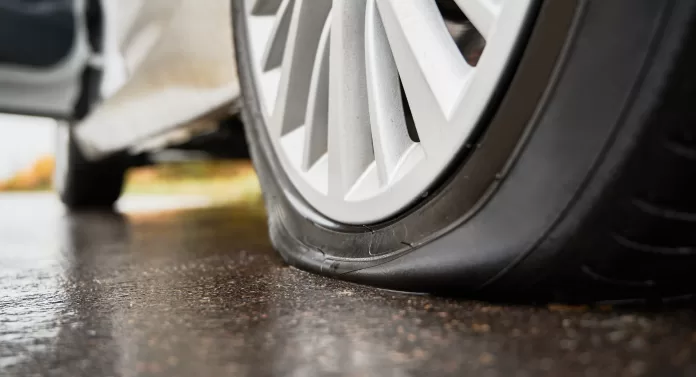Experiencing a tyre blowout while driving can be a terrifying event. In the blink of an eye, what was once a smooth journey can turn into a crisis that puts your safety at risk. That sudden, jarring sensation coupled with the discord of rubber tearing can send anyone’s heart racing. Blowouts can create severe hazards, leading to loss of control, swerving and potential accidents.
Here are the essential steps to take if you find yourself facing a tyre blowout.
Steps to Take During a Tyre Blowout
1. Remain Calm
The first step is to stay calm. It is essential to maintain your composure. Panic can cause you to make hasty decisions that might worsen the situation. Take a deep breath and focus on regaining control over the vehicle. Keeping a steady hand on the wheel can help you maintain control of the vehicle. Your training and instinct will help guide you safely through this moment.
2. Avoid Sudden Braking
Resist the temptation to hit the brakes hard to come to a stop. Instead, gently take your foot off the accelerator to reduce your speed gradually. Abrupt braking can lead to skidding, especially if you’re driving on a wet surface. If you have the space, let the car lose speed naturally and steer straight ahead to maintain stability. If you need to turn slightly to avoid an obstacle do so gradually as you signal oncoming and surrounding drivers. Once you have decreased your speed, gently apply the brakes to come to a stop.
3. Grip the Steering Wheel Firmly
When a tyre blows, you may feel your vehicle pulling sharply to one side or hear a loud noise, followed by a loss of speed. As soon as you realize you’ve had a blowout, grip the steering wheel firmly with both hands to maintain control. Avoid jerky movements, as sudden corrections can lead to loss of control.
4. Signal and Move to a Safe Location
When your speed has decreased enough and you feel more in control, signal to other drivers that you are pulling over and steer toward the shoulder of the road or an appropriate area away from traffic, such as a parking lot. Ensure you choose a flat and stable surface to stop.
5. Turn on Hazard Lights
As soon as you begin to pull over, turn on your hazard lights. This alerts other drivers that something is wrong and lets them know to give you space. Check your mirrors and use your turn signal to indicate your lane change. This precaution can help prevent accidents while you address the situation. Once you’ve safely pulled over, Put the vehicle in park and engage the parking brake, especially if you’re on an incline.
What to Do After Stopping
1. Ensure Your Safety
Check for oncoming traffic and ensure it’s safe to get out. Exit the vehicle carefully and if you have reflective triangles or flares, set them up to further alert other drivers of your presence.
2. Assess the Situation
Assess the condition of your tyre(s) and determine whether you can replace it yourself or if you need professional assistance. If it’s a complete blowout and the tyre is damaged beyond repair, you may need to call a roadside service or tow truck. Never attempt to change a tyre in a dangerous area, especially on a busy road or in inclement weather.
3. Change the Tyre (if comfortable)
If you have the technical know-how and the right equipment, such as a spare tyre, jack and tyre wrench, you can attempt to change the tyre yourself.
4. Call for Help
If you’re uncomfortable changing the tyre or if the blowout has caused other issues, don’t hesitate to call for professional help.
5. Get a Professional Inspection
Once you’ve dealt with the immediate situation, take your vehicle to a professional mechanic to inspect the other tyres and any potential damage caused by the blowout. The blowout may indicate an underlying issue, such as improper tyre pressure or alignment problems, which should be addressed to prevent future incidents.
Preventing Blowouts
While blowouts can occur unexpectedly, there are preventative measures you can take to minimize risk:
• Check Tyre Pressure Regularly: Maintain the appropriate tyre pressure, as underinflated tyres are more susceptible to blowouts.
• Inspect Tread Wear: Ensure that your tyres have adequate tread depth. Rotate your tyres regularly to promote even wear.
• Avoid Overloading: Don’t exceed your vehicle’s weight capacity, as this can strain tyres and lead to blowouts.
• Be Wary of Road Hazards: Drive cautiously on poorly-maintained roads and be mindful of potholes, debris and excessive speed.
Always prioritize your well-being and that of others while on the road.




